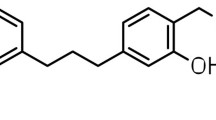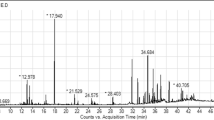Abstract
Background and Objective
MAMA decoction (MD) is an antimalarial product prepared from the leaves of Mangifera indica L. (Anacardiaceae), Alstonia boonei De Wild (Apocynaceae), Morinda lucida Benth (Rubiaceae) and Azadirachta indica A. Juss (Meliaceae). A previous report showed that MD enhanced the efficacy of amodiaquine (AQ) in malaria-infected mice, thus suggesting a herb–drug interaction. The present study hence evaluated the effect of MD on the disposition of AQ in mice with a view to investigating a possible pharmacokinetic interaction.
Methods
In a 3-period study design, three groups of mice (n = 72) were administered oral doses of AQ (10 mg/kg/day) alone, concurrently with MD (120 mg/kg/day), and in the 3rd period, mice were given AQ after a 3-day pre-treatment with MD. Blood samples were collected between 0 and 96 h for quantification of AQ and its major metabolite, desethylamodiaquine, by a validated high-performance liquid chromatography method.
Results
Maximum concentrations of AQ increased by 12% with the concurrent dosing of MD and by 85% in the group of mice pre-treated with MD. The exposure and half-life of desethylamodiaquine increased by approximately 11% and 21%, respectively, with concurrent administration. Corresponding increases of approximately 20% and 33% of desethylamodiaquine were also observed in mice pre-treated with MD.
Conclusion
MD influenced the pharmacokinetics of AQ and desethylamodiaquine, its major metabolite. The increase in the half-life and systemic exposure of AQ following its co-administration with MD may provide a basis for the enhanced pharmacological effect of the combination in an earlier study in Plasmodium-infected mice.



Similar content being viewed by others
References
Tomlinson B, Chan TY, Chan JC, Critchley JA, But PP. Toxicity of complementary therapies: an eastern perspective. J Clin Pharmacol. 2000;40(5):451–6.
Kinung’hi SM, Mashauri F, Mwanga JR, Nnko SE, Kaatano GM, Malima R, et al. Knowledge, attitudes and practices about malaria among communities: comparing epidemic and non-epidemic prone communities of Muleba district, North-western Tanzania. BMC Public Health. 2010;10(1):395–406.
Idowu OA, Mafiana CF, Luwoye IJ, Adehanloye O. Perceptions and home management practices of malaria in some rural communities in Abeokuta, Nigeria. Travel Med Infect Dis. 2008;6(4):210–4.
Farnsworth NR, Akerele O, Bingel AS, Soejarto DD, Guo Z. Medicinal plants in therapy. Bull World Health Organ. 1985;63(6):965–81.
WHO: World Health Organisation. World Malaria Report. 2018. https://www.who.int/news-room/fact-sheets/detail/malaria. Accessed on 15 May 2019.
Willcox ML, Bodeker G. Traditional herbal medicines for malaria. BMJ. 2004;329(7475):1156–9.
Amoah LE, Kakaney C, Kwansa-Bentum B, Kusi KA. Activity of herbal medicines on Plasmodium falciparum gametocytes: implications for malaria transmission in Ghana. PLoS One. 2015;10(11):e0142587.
Odugbemi TO, Akinsulire OR, Aibinu IE, Fabeku PO. Medicinal plants useful for malaria therapy in Okeigbo, Ondo State, Southwest Nigeria. Afr J Tradit Complement Altern Med. 2006;4(2):191–8.
Brantley SJ, Argikar AA, Lin YS, Nagar S, Paine MF. Herb-drug interactions: challenges and opportunities for improved predictions. Drug Metab Dispos. 2014;2(3):301–17.
Onyeji CO, Igbinoba SI, Olayiwola G, Adehin A. Insight into clinically effective herbal antimalarial products: effects on drug metabolizing enzymes and p-glycoprotein. Afr J Pharm Pharmacol. 2017;11(48):591–613.
Shi S, Klotz U. Drug interactions with herbal medicines. Clin Pharmacokinet. 2012;51(2):77–104.
Adepiti AO, Elujoba AA, Bolaji OO. In vivo antimalarial evaluation of MAMA decoction on Plasmodium berghei in mice. Parasitol Res. 2014;113(5):505–11.
Odediran SA, Elujoba AA, Adebajo AC. Influence of formulation ratio of the plant components on the antimalarial properties of MAMA decoction. Parasitol Res. 2014;113(5):1977–84.
Adepiti AO, Elujoba AA, Bolaji OO. Evaluation of herbal antimalarial MAMA decoction-amodiaquine combination in murine malaria model. Pharm Biol. 2016;54(10):2298–303.
Li XQ, Björkman A, Andersson TB, Ridderström M, Masimirembwa CM. Amodiaquine clearance and its metabolism to N-desethylamodiaquine is mediated by CYP2C8: a new high affinity and turnover enzyme-specific probe substrate. J Pharmacol Exp Ther. 2002;300(2):399–407.
Churchill FC, Patchen LC, Campbell CC, Schwartz IK, Nguyen-Dinh P, Dickinson CM. Amodiaquine as a prodrug: importance of metabolite (s) in the antimalarial effect of amodiaquine in humans. Life Sci. 1985;36(1):53–62.
Wang R, Zhang H, Sun S, Wang Y, Chai Y, Yuan Y. Effect of Ginkgo leaf tablets on the pharmacokinetics of amlodipine in rats. Eur J Drug Met Pharmacokinet. 2016;41(6):825–33.
Nwafor SV, Akah PA, Okoli CO, Oyirioha AC, Nworu CS. Interaction between chloroquine sulphate and aqueous extract of Azadirachta indica A. Juss (Meliaceae) in rabbits. Acta Pharm. 2003;53:305–11.
Mustapha KB, Bakare-Odunola MT, Garba M, Obodozie OO, Enemali IS, Inyan US. Effect of phytomedicines, AM-1, niprisan® and nifadin on the pharmacokinetics of chloroquine in rats. Eur J Drug Met Pharmacokinet. 2009;34(3–4):151–5.
Olawoye OS, Adeagbo BA, Bolaji OO. Effect of Moringa oleifera leaf powder suspension on the pharmacokinetics of amodiaquine in rats. J Complement Alt Med Res. 2017;3(4):1–8.
National Research Council. Guide for the care and use of laboratory animals. 8th ed. Washington DC: National Academy Press; 1996.
Adedeji ON, Bolaji OO, Falade CO, Osonuga OA, Ademowo OG. Validation and pharmacokinetic application of a high-performance liquid chromatographic technique for determining the concentrations of amodiaquine and its metabolite in plasma of patients treated with oral fixed-dose amodiaquine-artesunate combination in areas of malaria endemicity. Antimicrob Agents Chemother. 2015;59(9):5114–22.
United States Food and Drug Administration: Bioanalytical Method Validation: Guidance for Industry. 2018.
Winstanley P, Edwards G, Orme M, Brekenridge A. The disposition of amodiaquine in man after oral administration. Br J Clin Pharmacol. 1987;23(1):1–7.
United States Food and Drug Administration. Guidance for industry: bioavailability and bioequivalence studies for orally administered drug products – general considerations. Rockville, MD: US Department of Health and Human Services, FDA, Center for Drug Evaluation and Research; 2003.
Mariga ST, Gil JP, Sisowath C, Wernsdorfer WH, Björkman A. Synergism between amodiaquine and its major metabolite, desethylamodiaquine, against Plasmodium falciparum in vitro. Antimicrob Agents Chemother. 2004;48(11):4089–96.
Winstanley PA, Edwards G, Curtis CG, Orme M, Powel GM, Breckenridge AM. Tissue distribution and excretion of amodiaquine in the rat. J Pharm Pharmacol. 1988;40(5):343–9.
Rodeiro I, José Gómez-Lechón M, Perez G, Hernandez I, Herrera JA, Delgado R, et al. Mangifera indica L. extract and mangiferin modulate cytochrome P450 and UDP-glucuronosyltransferase enzymes in primary cultures of human hepatocytes. Phytother Res. 2013;27(5):745–52.
Showande SJ, Fakeye TO, Kajula M, Hokkanen J, Tolonen A. Potential inhibition of major human cytochrome P450 isoenzymes by selected tropical medicinal herbs—implication for herb–drug interactions. Food Sci Nutr. 2019;7(1):44–55.
Chieli E, Romiti N, Rodeiro I, Garrido G. In vitro effects of Mangifera indica and polyphenols derived on ABCB1/P-glycoprotein activity. Food Chem Toxicol. 2009;47(11):2703–10.
Kawami M, Yamada Y, Issarachot O, Junyaprasert VB, Yumoto R, Takano M. P-gp modulating effect of Azadirachta indica extract in multidrug-resistant cancer cell lines. Pharmazie. 2018;73(2):104–9.
Szakács G, Váradi A, Özvegy-Laczka C, Sarkadi B. The role of ABC transporters in drug absorption, distribution, metabolism, excretion and toxicity (ADME-Tox). Drug Discov Today. 2008;13(9–10):379–93.
Acknowledgements
AOA is grateful to the Obafemi Awolowo University (OAU), Nigeria, for support under the Staff Development Programme. The OAU Research Committee is acknowledged for Grant 11813AFL. The authors are grateful to the Carnegie Foundation/Therapeutic Drug Monitoring Laboratory, OAU Teaching Hospitals Complex, Ile-Ife, Nigeria for the high-performance liquid chromatography facility.
Author information
Authors and Affiliations
Corresponding author
Ethics declarations
Funding
Support for the study was provided by the Obafemi Awolowo University, Ile-Ife, Nigeria under the Staff Development Programme and the University Research Committee Grant 11813AFL.
Conflict of interest
The authors declare no conflict of interest.
Ethics approval
Approval for the study was obtained from the Health Research Ethics Committee of the Obafemi Awolowo University, Ile-Ife, Nigeria (IPHOAU/12/90). “The Guide for the care and use of laboratory animals” was strictly followed.
Rights and permissions
About this article
Cite this article
Adepiti, A.O., Adeagbo, B.A., Adehin, A. et al. Influence of MAMA decoction, an Herbal Antimalarial, on the Pharmacokinetics of Amodiaquine in Mice. Eur J Drug Metab Pharmacokinet 45, 81–88 (2020). https://doi.org/10.1007/s13318-019-00583-7
Published:
Issue Date:
DOI: https://doi.org/10.1007/s13318-019-00583-7




